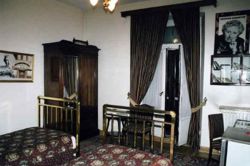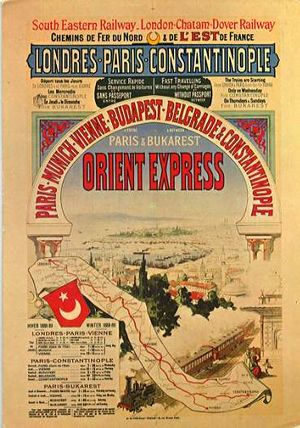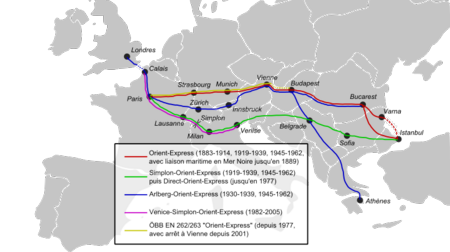Orient Express
Orient Express is the name of a long-distance passenger train originally operated by the Compagnie Internationale des Wagons-Lits. Its route has changed many times, and several routes have in the past concurrently used the name. Although the original Orient Express was simply a regular international railway service, the name has become synonymous with luxury travel. The current Orient Express runs from Paris to Vienna. It is expected to be discontinued on June 9, 2007,[1] with the inauguration of the TGV Est.
Contents
The original Orient Express
The original route, which first ran on October 4 1883, was from Paris to Giurgiu in Romania via Munich and Vienna. At Giurgiu, passengers were ferried across the Danube to Rousse in Bulgaria to pick up another train to Varna, from where they completed their journey to Istanbul by ferry. In 1885, another route began operations, this time reaching Istanbul via rail from Vienna to Belgrade and Niš, carriage to Plovdiv and rail again to Istanbul.
1889 saw the completion of a direct rail line to Istanbul. The Orient Express at this time ran daily from Paris to Budapest, three times a week onwards to Belgrade and Istanbul, and once weekly to Bucharest and Constanţa, on the Black Sea.
Later the same year, the train's eastern terminus became Varna in Bulgaria, where passengers could take a ship to Istanbul. In 1889 the train began running non-stop all the way to Istanbul, which remained its easternmost stop until May 19, 1977. The eastern terminus was the Sirkeci Terminal by the Golden Horn. Ferry service from piers next to the terminal would take passengers across the Bosporus Strait to Haydarpaşa Terminal, the terminus of the Asian lines of the Ottoman railways.
World War One
The onset of World War I in 1914 saw Orient Express services suspended. They resumed at the end of hostilities in 1918, and in 1919 the opening of the Simplon Tunnel allowed the introduction of a more southerly route via Milan, Venice and Trieste. The service on this route was known as the Simplon Orient Express, and it ran in addition to continuing services on the old route. The Treaty of Saint-Germain contained a clause requiring Austria to accept this train: formerly, Austria only allowed international services to pass through Austrian territory (which included Trieste at the time) if they ran via Vienna. The Simplon Orient Express soon became the most important rail route between Paris and Istanbul.
The heyday of the Orient Express
The 1930s saw the zenith of Orient Express services, with three parallel services running: the Orient Express, the Simplon Orient Express, and also the Arlberg Orient Express, which ran via Zurich and Innsbruck to Budapest, with sleeper cars running onwards from there to Bucharest and Athens. During this time, the Orient Express acquired its reputation for comfort and luxury, carrying sleeping-cars with permanent service and restaurant cars known for the quality of their cuisine. Royalty, nobles, diplomats, business people and the bourgeoisie in general patronized it. Each of the Orient Express services also incorporated sleeping cars which had run from Calais to Paris, thus extending the service right from one edge of continental Europe to the other.
World War Two
The start of the Second World War in 1939 again interrupted the service, which did not resume until 1945. During the war, the German Mitropa company had run some services on the route through the Balkans, but partisans frequently sabotaged the track, forcing a stop to this service.
Following the end of the war, normal services resumed except on the Athens leg, where the closure of the border between Yugoslavia and Greece prevented services running. That border re-opened in 1951, but the closure of the Bulgaria-Turkey border from 1951 to 1952 prevented services running to Istanbul during that time. As the Iron Curtain fell across Europe, the service continued to run, but the communist nations increasingly replaced the Wagon-Lits cars with carriages run by their own railway services.
Direct Orient Express
By 1962, the Orient Express and Arlberg Orient Express had stopped running, leaving only the Simplon Orient Express. This was replaced in 1962 by a slower service called the Direct Orient Express, which ran daily cars from Paris to Belgrade, and twice weekly services from Paris to Istanbul and Athens.
In 1971, the Wagon-Lits company stopped running carriages itself and making revenues from a ticket supplement. Instead, it sold or leased all its carriages to the various national railway companies, but continued to provide staff for the carriages. 1976 saw the withdrawal of the Paris-Athens direct service, and in 1977, the Direct Orient Express was withdrawn completely, with the last Paris-Istanbul service running on 19 May 1977.
The withdrawal of the Direct Orient Express was thought by many to signal the end of Orient Express as a whole, but in fact a service under this name continued to run from Paris to Budapest and Bucharest as before. This continued until 2001, when the service was cut back to just Paris-Vienna. This service continues daily under the name Orient Express as of 2005.
Today, the fastest way to travel by train from Paris to Istanbul is by three trains: Paris-Vienna, Vienna-Belgrade and Belgrade-Istanbul, which operate daily.
Homonym
A train called Orient-Express by the SNCF (Société Nationale des Chemins de fer Français) ran daily till the mid-1970s starting from Paris Gare de l'Est to Châlon-sur Saône, Nancy, Strasbourg, Stuttgart, Munich, Budapest and (part of it going to) Bucharest. It used to leave Paris each day at 10:15 pm. French cheminots originating from the former Réseau de l'Est insisted on the fact that this was the "real" Orient Express and that the other one was just a fake, that they generally called "Direct Orient".
The interesting feature of that train - or more exactly of that train set, since the return trip took more than one day to complete - was its heterogeneous assembly of rolling material coming from France, Germany, Austria, Hungary and Romania, which allowed people to easily compare the choices of these countries and to choose the one that suited one most. Of course, the sleeping car and the wagon-restaurant belonging to the Compagnie Internationale de Wagons-Lits were there too.
Privately run trains using the name
In 1982, the Venice-Simplon Orient Express was established as a private venture, running restored 1920s and 1930s carriages from London and Paris to Venice. This service is today run once a week from March to November, and is firmly aimed at leisure travellers, with tickets costing over £1,200 per person from London to Venice.
The American Orient Express operates in the western United States as well as parts of Canada and Mexico. It is advertised as a sort of combination of a cruise ship and a 5 star hotel. It has recently changed its name to GrandLuxe Rail Journeys.
The Orient Express in popular culture

The Orient Express has frequently appeared in books and films, often serving as a venue for mysteries and intrigues. The action of Agatha Christie's novel Murder on the Orient Express is set on the Simplon Orient Express, while Graham Greene's book Stamboul Train is set on another Orient Express service.
The first movie Orient Express was shown in 1934. The German movie Orient-Express was made in 1944 and released on March 8, 1945, likely the last date a new movie was shown in Nazi Germany. There is also a 2000 movie, Death, Deceit and Destiny Aboard the Orient Express, and in the 2004 version of Around the World in 80 Days, Mr. Fogg rides aboard the train to Istanbul. Sir Harry Paget Flashman travels on the train's first journey as a guest of the journalist Henri Blowitz in George MacDonald Fraser's book Flashman and the Tiger. James Bond's troubled escape in From Russia with Love is also set aboard the train.
A famous scenario for Call of Cthulhu RPG is set in the Orient-Express. The Orient Express also plays host to an adventure game by Jordan Mechner. The Last Express is a murder mystery game which is set around the last ride of the Orient Express before it suspended operations at the start of World War I. Most of the episode Turtles on the Orient Express of the 1987 Teenage Mutant Ninja Turtles cartoon takes place on the Orient Express. The Orient Express was also featured prominently in an episode of Star Trek: The Next Generation called "Emergence", in which the train appears on the Enterprise's holodeck. In 1994's Season 1 episode of "Where on Earth is Carmen Sandiego?" called, "The Gold Old Bad Days", Ms. Carmen Sandiego and her V.I.L.E. gang are give a challenge to do something low tech by The Player robbery. Carmen's goal is the train. In the Lord Darcy alternate history series of detective stories, one story takes place on board a fictional train clearly modeled in the Orient Express, though its name and route are different.
See also
References
- ↑ Vorschau auf den Fahrplan 2007 (German) (2006-09-30). Retrieved on 2006-10-14.
External links
- The truth behind the legend
- A history from the original operators of the train
- Article (2005) in 'hidden europe' magazine that picks up some the points discussed in this entry
- Venice Simplon-Orient-Express
da:Orientekspressen de:Orient-Express el:Οριάν Εξπρές es:Orient Express eo:Orient-Express fr:Orient-Express it:Orient Express (treno) he:אוריינט אקספרס ka:აღმოსავლეთის ექსპრესი nl:Oriënt-Express ja:オリエント急行 no:Orientekspressen pl:Orient Express pt:Expresso do Oriente ru:Восточный экспресс fi:Idän pikajuna sv:Orientexpressen tr:Şark Ekspresi


